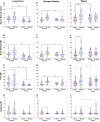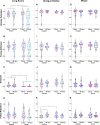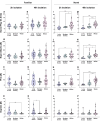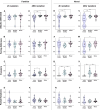This is a preprint.
To Play or Not to Play? Effects of Playmate Familiarity and Social Isolation on Social Play Engagement in Three Laboratory Rat Strains
- PMID: 39605718
- PMCID: PMC11601367
- DOI: 10.1101/2024.11.14.623692
To Play or Not to Play? Effects of Playmate Familiarity and Social Isolation on Social Play Engagement in Three Laboratory Rat Strains
Abstract
Social play is a motivating and rewarding behavior displayed by juveniles of many mammalian species, including humans and rats. Social play is vital to the development of social skills. Autistic children show less social play engagement which may contribute to their impairments in social skills. There is limited knowledge about what external conditions may positively or negatively influence social play engagement in humans or other animals. Therefore, we determined how two common external conditions, playmate familiarity and social isolation, modulate social play levels and social play defense tactics in juveniles of three common laboratory rat strains: Long-Evans, Sprague-Dawley, and Wistar. Males and females were socially isolated for either 2h or 48h prior to social play testing and were then exposed to either a familiar (cage mate) or novel playmate, creating four testing conditions: 2h-Familiar, 48h-Familiar, 2h-Novel, and 48h-Novel. Both playmate familiarity and social isolation length influenced social play behavior levels and tactics in juvenile rats, but did so differently for each of the three rat strains. Long-Evans played most with a familiar playmate, irrespective of time isolated, Sprague-Dawley played most in the 48h-Familiar condition, and Wistar played the least in the 2h-Familiar condition, but Wistar played more with a novel playmate than Long-Evans and Sprague-Dawley. Analysis of social play tactics by the playmates in response to nape attacks by the experimental rats revealed strain differences with novel playmates. Here, Sprague-Dawley and Wistar defended more nape attacks than Long-Evans. Sprague-Dawley evaded these attacks, thereby shortening body contact. In contrast, Wistar turned to face their playmate attacker and showed more complete rotations, thereby extending body contact and wrestling longer. Role reversals, which increase social play reciprocity and reflect the quality of social play, were higher in Long-Evans and Sprague-Dawley with familiar playmates. Role reversals decreased for Sprague-Dawley but increased for Wistar after 48h isolation. The effects of playmate familiarity or social isolation length on social play levels and tactics were similar across sex for all three strains. In conclusion, we showed that two common external factors (playmate familiarity and social isolation length) that largely vary across social play studies have a major impact on the level and quality of social play in the three rat strains. Strain differences indicate higher level and quality of social play with familiar playmates in Long-Evans, with familiar playmates after short isolation in Sprague-Dawley, and with novel playmates after longer isolation for Wistar. Future research could determine whether strain differences in neuronal mechanisms underlie these condition-induced variations in social play engagement. Our findings are also informative in suggesting that external conditions like playmate familiarity and social isolation length could influence social play levels and social play quality in typical and atypical children.
Figures








Similar articles
-
Sex differences in juvenile play behavior differ among rat strains.Dev Psychobiol. 2018 Dec;60(8):903-912. doi: 10.1002/dev.21760. Epub 2018 Jul 3. Dev Psychobiol. 2018. PMID: 29969514
-
Prenatal hormones and childhood sex segregation: playmate and play style preferences in girls with congenital adrenal hyperplasia.Horm Behav. 2011 Apr;59(4):549-55. doi: 10.1016/j.yhbeh.2011.02.007. Epub 2011 Feb 19. Horm Behav. 2011. PMID: 21338606 Free PMC article.
-
Strain- and context-dependent effects of the anandamide hydrolysis inhibitor URB597 on social behavior in rats.Eur Neuropsychopharmacol. 2014 Aug;24(8):1337-48. doi: 10.1016/j.euroneuro.2014.05.009. Epub 2014 May 20. Eur Neuropsychopharmacol. 2014. PMID: 24933531
-
Domestication and diversification: a comparative analysis of the play fighting of the Brown Norway, Sprague-Dawley, and Wistar laboratory strains of (Rattus norvegicus).J Comp Psychol. 2014 Aug;128(3):318-27. doi: 10.1037/a0036104. Epub 2014 Apr 21. J Comp Psychol. 2014. PMID: 24749500
-
Social play behavior, ultrasonic vocalizations and their modulation by morphine and amphetamine in Wistar and Sprague-Dawley rats.Psychopharmacology (Berl). 2014 Apr;231(8):1661-73. doi: 10.1007/s00213-013-3337-9. Epub 2013 Nov 13. Psychopharmacology (Berl). 2014. PMID: 24221828
Cited by
-
Juvenile male rats form preferences based on strain when playing in groups but not in pairs.Front Behav Neurosci. 2025 Jul 10;19:1617178. doi: 10.3389/fnbeh.2025.1617178. eCollection 2025. Front Behav Neurosci. 2025. PMID: 40708845 Free PMC article.
References
-
- Altmann S.A., 1962. Social behavior oxf anthropoid primates: Analysis of recent concepts., in: Roots of Behaviour. Bliss E.L. (Ed.), Hoeber, New York, pp. 277–285.
-
- Barnett L., 1990. Playfulness: Definition, design, and measurement, in: Play and Culture. pp. 319–336.
Publication types
Grants and funding
LinkOut - more resources
Full Text Sources
